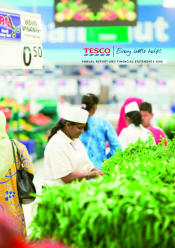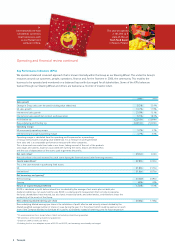Tesco 2006 Annual Report Download - page 7
Download and view the complete annual report
Please find page 7 of the 2006 Tesco annual report below. You can navigate through the pages in the report by either clicking on the pages listed below, or by using the keyword search tool below to find specific information within the annual report.
5Tesco plc 5
4
Since 1992
Computers for
Schools have given
out over £100m
worth of computers
and IT equipment.
4
Our customers
in South Korea
can now take
advantage of our
financial services.
Property funding and conserving equity
Wehave sought freehold tenure for most of our new selling
space in recent years because leased developments have in
the past tended to give disproportionate rewards to landlords,
making it hard to remodel or expand stores. As a result,
freehold properties now represent significantly more of our
property assets – around 85% of book value – compared with
historic levels of around 70%. A strength of our Balance Sheet
is this asset-backing; the net book value of our fixed assets is
£15.9bn, most of it in freehold property valued at historic cost.
These appreciating freehold assets, whose market value we
estimate to be around 50% higher than book value, provide us
with the platform we require as retailers to expand and develop
our stores for customers and they also represent an important
store of value for our shareholders. Through capital expenditure
we are currently adding some £2bn of new freehold assets a year.
Over the lasttwo years, through our joint ventures with
Topland, Consensus and Morley, Tesco has developed an
updated version of our property joint ventures. These provide
us with the right platform to run our stores. At the same time,
they have enabled us to fund our growth efficiently by releasing
cash from our freehold property base, create a stream of
material property profits and enhance returns.
Looking forward, we plan to release more cash from property
in the same way, through a sequence of similar joint venture
deals, both in the UK and internationally.Weintend to
maintain an overall asset mix of over 70% freehold. The total
scale of this sale and leaseback programme in terms of cash
proceeds over the next five years is expected to be up to £5bn.
At least£1.5bn of theseproceeds will be used to buy Tesco
shares in the market, initially to offset future dilution to
earnings per share caused by scrip dividend and share option
issuance. The balance will mainly be used to fund the growth
of the business.
Pensions
The provision of Tesco’s award-winning UK defined benefit
pension scheme for our staff remains an important priority. It
goes to the heart of our values and helps us attract and retain
the best people. During the year, the Trustee board completed
its three-yearly valuation of the pension fund. In March 2005,
it had a small deficit of £153m in a scheme which now has
over £3bn of assets. As at February 2006, the scheme was
estimated to be fully funded, largely as a result of improved
asset performance. In recognition of the increasing cost of
pensions we have recently increased both the Company and
member contributions.
It is a young scheme. With around 150,000 employed
members but only about 15,000 pensioners, the scheme has
many years to ensure that the type of assets held match its
liabilities. The fund’s strategy is to invest in 50% equities, 20%
bonds, 10% property and 20% alternative asset classes,
including privateequity and commodities. It offers the
prospect, over time, of returns that should make the scheme
more cost efficient for the members and the business. In 2005,
the scheme’s assets appreciated by around 20%.
IFRSs require that we value pension scheme liabilities using a
high quality corporate bond yield, and calculate the operating
charge in the Income Statement as if invested purely in bonds.
This has proven to be an extremely volatile measure. During a
two-week period in January 2006, for example, bond yields fell
by 20 basis points, increasing our IAS 19 ‘Employee benefits’
liability by £200m (before tax). At February 2006, the IAS 19
pension deficit was around £850m on a post-tax basis. Mainly
as a consequenceof bond yields falling by 0.6% during
2005/06 as a whole, our IFRS pensions charge for next year
could increase by approximately £130m.
We will, of course, produce our accounts in full compliance with
IFRSs. However, we intend to include in our new underlying
profit number,the normal cash costof funding the pension
to reflect how the fund is actually managed and funded.




















